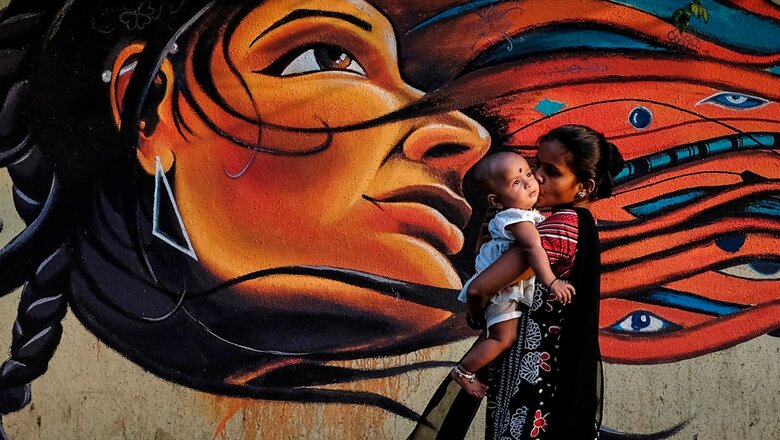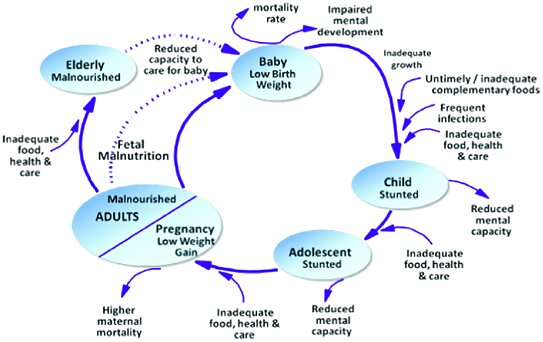
views
Adequate nutrition is critical for women’s health and the health of their children. Breaking the intergenerational cycle of undernutrition is one of the key ways to eliminate malnutrition in India. As indicative in figure 1, under-nourished women, in all likelihood, become under-nourished mothers with a greater chance of giving birth to underweight babies who grow into stunted children with reduced mental capacity, have lower resistance to infections and higher risk of morbidity and mortality throughout their lives.

Figure 1: Poor Nutrition throughout the life cycle
About one in five women (18.7 per cent) of reproductive age (15-49 years) in India are thin, with a body mass index (BMI) of less than 18.5 kilograms per square metre, perpetuating an intergenerational cycle of malnutrition. The proportion is higher in rural areas (21.2 per cent) than in urban areas (13.1 per cent). Almost a quarter of women (23.3 per cent) are married before they turn 18. Inadequate nutrition before conception and during the first trimester of pregnancy is largely responsible for foetal stunting. Investing in maternal and child health yields a high cost to benefit ratio, with a triple dividend in both low- and upper-middle income countries.
The government of India has taken significant measures to combat malnutrition over the past few decades through the Integrated Child Development Scheme and the Anganwadi system — to provide supplementary nutrition and ration to pregnant and lactating women, run mid-day meal scheme in schools and maternity benefit programme, and mandate provision of grains at subsidised rates through the public distribution system (PDS). The National Food Security Act 2013 assures food and nutrition security to the vulnerable and that access to food is a legal right. India’s flagship programme ‘POSHAN Abhiyaan’ launched on the International Women’s Day in 2018 aims to improve nutritional outcomes for children, pregnant women and lactating mothers.
Despite all efforts and programmes, women’s health and education continue to be neglected. There is an intersection of low education in women, poverty and malnutrition. According to World Bank, educating girls and ending child marriage are central to eradicating poverty. The UN’s sustainable development goals call for gender equality and access to quality education by 2030. Education enables socioeconomic mobility and is therefore the key to escaping poverty.
With women constituting almost half of India’s population at 48 per cent and contributing 18 per cent to the GDP, a lot needs to be done to address the challenges faced by women. The COVID-19 crisis has led to women bearing the double brunt of economic and social fallout. According to the World Bank, the pandemic has pushed another 150 million people into extreme poverty. This calls for effective implementation of programmes and allocation of budget.
The Union Budget 2021-22 was disheartening with reduced allocation for crucial social security programmes for women and children despite the challenges faced by women due to the pandemic. The budget of the Ministry of Women and Child Development was reduced by 0.7 per cent. Mission POSHAN 2.0 was launched to strengthen nutritional content, delivery and outcome; however, the budget allocation for the POSHAN scheme showed a steep decline of 27 per cent (from Rs 3700 crore to Rs 2700 crore).
Despite less-than-remarkable implementation of POSHAN Abhiyaan, POSHAN 2.0 was launched by clubbing schemes under SAKSHAM and SAMARTHYA. The budget was lowest for children at 2.46 per cent. The gender budget trends were underwhelming. The schemes were not given their due in the budget, with a drastic slash in maternity entitlement scheme. The estimates were revised by 48 per cent leaving out half of the women beneficiaries.
This shows poor implementation of schemes leading to a decline in beneficiaries availing it. Budget allocations also seem to neglect adolescent nutrition even as data indicates high micronutrient deficiencies and poor nutritional status among them. Schemes for adolescent girls that address their health and nutrition call for higher allocation and strengthened implementation to improve the declining coverage. Another drastic decline (from Rs 726 crore to Rs 48 crore) was seen in the Mission for Protection and Empowerment of Women, indicating sheer neglect of vulnerable women and girls as against the expectation of transformative opportunity. According to experts, “the Budget announced POSHAN Mission 2.0 (but it) would be effective only if feeding and not mere provision gets the budget share.” Budget 2021 seemed to have paid a lip service to women’s health and nutrition.
Union Budget 2022-23 looks to continue to focus on ‘agriculture, rural connectivity, drinking water mission, Swachh Bharat Abhiyan (Clean India mission), nutrition, and health and education, including mid-day meal scheme’. There is an urgent need to invest in women and children’s health for sustainable development along with saving lives and improving quality of life. Focus on ‘Gender Budgeting’ is needed as it has multi-sectoral impact on lives of women and girls.
We must continue to invest in programmes targeting social protection, early child development, education, and water and sanitation to enhance effectiveness of nutrition-specific interventions. With the disruption of nutritional services during the pandemic due to loss of livelihoods, it is essential to provide for the needs of the nation. The relief package under the Pradhan Mantri Garib Kalyan Yojana for the poorest of poor needs to be continued and budgeted along with universalisation of PDS. Finally, the budget should allocate sufficient funds for women’s health, maternity entitlements and safety — for economic growth.
Hoping for a budget with transformational reforms for women and girls for an inclusive and equitable post-COVID recovery.
Dr Shoba Suri is a Senior Fellow with ORF’s Health Initiative. She is a nutritionist with experience in community and clinical research. The views expressed in this article are those of the author and do not represent the stand of this publication.
Read all the Latest Opinions here



















Comments
0 comment